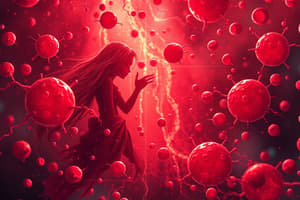Podcast
Questions and Answers
What is a key aspect of Cooley's concept of groups?
What is a key aspect of Cooley's concept of groups?
- They are only formed for specific goals.
- They exist solely online.
- They include both primary and secondary types. (correct)
- They do not influence individual behavior.
Which of the following is NOT a type of group according to Cooley?
Which of the following is NOT a type of group according to Cooley?
- Secondary group
- Reference group
- Tertiary group (correct)
- Primary group
Which characteristic best describes Cooley's primary groups?
Which characteristic best describes Cooley's primary groups?
- They are temporary and transitory.
- They are based on intimate and personal relationships. (correct)
- They function solely for economic purposes.
- They have a formal structure.
What role do secondary groups play according to Cooley?
What role do secondary groups play according to Cooley?
How do Cooley's reference groups influence individuals?
How do Cooley's reference groups influence individuals?
Flashcards are hidden until you start studying
Study Notes
Cooley's Concept of Groups
- Cooley emphasized the social nature of individuals, asserting that personal identity develops through interactions within groups.
- His concept includes two main types of groups: primary and secondary.
Types of Groups According to Cooley
- Primary groups are characterized by close, intimate relationships, such as family and friends.
- Secondary groups are more impersonal and focused on specific goals or tasks, like work or professional organizations.
- A group that does not fit within Cooley's classifications, such as an abstract category or a temporary association without a common goal, is NOT considered a type of group.
Characteristics of Cooley's Primary Groups
- Primary groups display strong emotional ties and a high level of personal interaction.
- They provide emotional support, a sense of belonging, and socialization functions crucial in formative years.
Role of Secondary Groups
- Secondary groups serve a pragmatic purpose, often aimed at achieving specific objectives or outcomes.
- Relationships in secondary groups tend to be more transient and less emotionally based compared to primary groups.
Influence of Reference Groups
- Reference groups serve as standards for evaluating one’s beliefs, behaviors, and attitudes.
- Individuals often compare themselves to these groups, impacting their self-perception and aspirations.
Studying That Suits You
Use AI to generate personalized quizzes and flashcards to suit your learning preferences.




